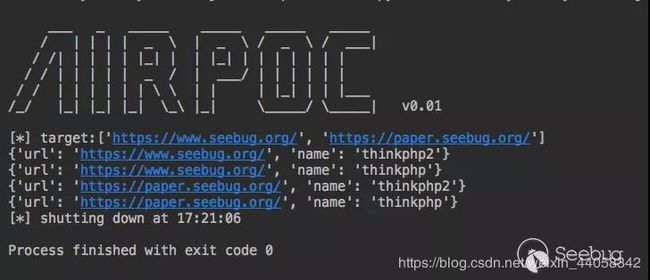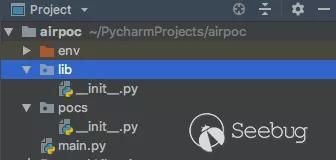如何打造自己的PoC框架-Pocsuite3-框架篇
本节笔者将按照Pocsuite框架结构以及工程化实践,来实现一款自己的PoC框架。为了开一个好头,我们先取一个好听的名字,想威武霸气一些可以取上古神器之类的,诸如轩辕夏禹赤霄干将,若怀着对游戏的热爱也可以有山丘之王(Mountain King)剑圣(BladeMaster)月之女神(Priess Of the moon)。由于笔者比较懒,我们就取一个朴素的名字:AirPoc,中文名叫它"空气炮"吧。
名称取好了,我们还要幻想一下大饼。这里请充分发挥想象力,幻想它的功能,你要记住,没有我们实现不了的功能,如果有,打死产品manager即可。
这里不妨开下脑洞,为了组建兔子安全联盟,我们计划开发一款基于区块链的PoC验证框架AirPoc,限定只对"兔子安全联盟”范围内的网站进行安全检查,由一个AirPoc节点检查出了存在漏洞的地址,将URL和PoC共享到区块中,再由随机的其他节点验证,验证成功则获得"空气币",而被检测到的网站所有者则需要支付"空气币"作为报酬。
虽然只是暂时的幻想,但是产品小哥哥也略带激动整理出了我们需要的功能。
使用简单,不要有太多的命令,可以跨平台使用
人多力量大,能让更多人参与进来的
能简单操作就能内置到其他产品上
验证速度与验证准确率极高!
我也不知道什么好,总之你跑起来能出东西就行!
当然,这位产品小哥哥可能怕被打,没有将分布式,区块链的概念加入进来。
具体细节
下面就由笔者来具体实现由笔者兼职的产品manager随便一想(挖坑)的东西。我们逐一分析问题,并给出最后的解决方案。
说到使用简单,我们就任性的选择使用Python了,不信你看看Python之父的头发。在安装了Python之后,也可以一份代码多处使用,但为了足够的简单与原生,我们决定尽量少使用Python的第三方包。而目前Python最新版为3.7,我们就以此为例。
国外的众多开源安全项目都有不少人参与,像Metasploit

能贡献一份代码到上面可能是安全研究人员最想做的事情吧。
所以笔者有个想法是AirPoc的PoC仓库可以开源到GitHub,并且能够在线调用上面的PoC,这样也不会为了PoC的更新而烦恼了。
内置到其他产品也更是容易,如果是Python类的软件,可以直接把AirPoc当做包来调用,如果其他软件,AirPoc可以开放一个RPC接口提供使用,如果不想要Python的环境,也可以通过pyinstaller之类的工具打包,我们的设计原则是尽量不依赖其他第三方库,所以也会避免很多奇奇怪怪的问题。
想要实现验证速度与验证准确率极高,我们要做好多线程或协程的并发模型,这里我们会在后面在详细叙述。
最后,“我也不知道什么好,总之你跑起来能出东西就行!”,如果上面的事情我们都做好了,这个应该就是水到渠成的了~
AirPoc的框架
在完成这个"宏伟计划"之前,我们也需要设计一下整体的代码框架。作为一名代码洁癖患者,一个良好的代码结构,是万里长征的第一步。我们建立如下的目录结构,env是虚拟环境,建立两个目录lib、pocs,lib用于存储之后的相关核心文件,pocs用于存储poc文件,和一个文件main.py用作初始入口。
就像盖大楼需要打好地基,接下来完成基础框架,我们可以先不用写具体的功能,但是了解作为"地基"的函数的意义。如下,在main.py文件中如下代码,一个初始的框架就完成了。
import os
import time
def banner():
msg = '''
___ _ _____ _____ _____ _____
/ | | | | _ \ | _ \ / _ \ / ___|
/ /| | | | | |_| | | |_| | | | | | | |
/ / | | | | | _ / | ___/ | | | | | |
/ / | | | | | | \ \ | | | |_| | | |___
/_/ |_| |_| |_| \_\ |_| \_____/ \_____| {}
'''.format(version)
print(msg)
def init(config: dict):
print("[*] target:{}".format(config["url"]))
def end():
print("[*] shutting down at {0}".format(time.strftime("%X")))
def start():
pass
def main():
banner()
config = {
"url": "https://www.seebug.org/"
}
init(config)
start()
end()
if __name__ == '__main__':
version = "v0.00000001"
main()

但是,正如你所见,版本号和我的比特币钱包的数字竟然差不多,我们还要给它加些料。
- 单例模式
在我们软件的初始化的工程中,我们需要得到很多环境相关的信息。比如当前执行的路径是哪?poc目录在哪?我们输出结果文件输出到哪个路径等等。
它们有一个共同的特定是,它们只需要加载一次,在后面使用中直接拿来用就行了。这种模式在软件设计模式中有一个单独的名词,“单例模式”。
幸运的是python的模块就是天然的单例模式,因为模块在第一次导入时,会生成 .pyc 文件,当第二次导入时,就会直接加载 .pyc 文件,而不会再次执行模块代码。因此,我们只需把相关的函数和数据定义在一个模块中,就可以获得一个单例对象了。
我们在lib目录里面新建一个data.py用于存储这些信息。同时将版本信息也放到这里来。
import os
PATHS_ROOT = os.path.join(os.path.dirname(os.path.realpath(__file__)), "../")
PATHS_POCS = os.path.join(PATHS_ROOT, "pocs")
PATHS_OUTPUT = os.path.join(PATHS_ROOT, "output")
VERSION = "v0.0000001"
为了更好的来表示这些常量,我们用PEP8标准里的规范,统一约定用大写和下划线来表示常量。为了说明与之前的区别,我们象征性的将VERSION减一个0,来表达我们的比特币又增长了10倍。
- 动态加载
在解决完我们相关的环境问题后,我们在看看如何动态加载模块。在具体细节里我们说过,我们期望PoC能够从本地或者远程网站(如GitHub)上加载。
这里又得分成两种情况,如果是通过文件路径加载动态加载的模块,可以直接用__import__()来加载,但是如果要远程加载,可能就又会复杂一点,根据python的相关文档,我们要自己实现"查找器"与"加载器" https://docs.python.org/zh-cn/3/reference/import.html。
当然,你也可以从远程保存到本地后,按照本地加载模式进行加载。但是Pocsuite已经有完整的加载器代码了,我们可以直接拿来用。
新建lib/loader.py文件
import hashlib
import importlib
from importlib.abc import Loader
def get_md5(value):
if isinstance(value, str):
value = value.encode(encoding='UTF-8')
return hashlib.md5(value).hexdigest()
def load_string_to_module(code_string, fullname=None):
try:
module_name = 'pocs_{0}'.format(get_md5(code_string)) if fullname is None else fullname
file_path = 'airpoc://{0}'.format(module_name)
poc_loader = PocLoader(module_name, file_path)
poc_loader.set_data(code_string)
spec = importlib.util.spec_from_file_location(module_name, file_path, loader=poc_loader)
mod = importlib.util.module_from_spec(spec)
spec.loader.exec_module(mod)
return mod
except ImportError:
error_msg = "load module '{0}' failed!".format(fullname)
print(error_msg)
raise
class PocLoader(Loader):
def __init__(self, fullname, path):
self.fullname = fullname
self.path = path
self.data = None
def set_data(self, data):
self.data = data
def get_filename(self, fullname):
return self.path
def get_data(self, filename):
if filename.startswith('airpoc://') and self.data:
data = self.data
else:
with open(filename, encoding='utf-8') as f:
data = f.read()
return data
def exec_module(self, module):
filename = self.get_filename(self.fullname)
poc_code = self.get_data(filename)
obj = compile(poc_code, filename, 'exec', dont_inherit=True, optimize=-1)
exec(obj, module.__dict__)
具体如何实现的我们可以不用关心,我们只需要知道,其中我们可以用load_string_to_module来从源码中加载模块了。如果你有兴趣了解具体的实现,可以参考上面的python官方文档。
规则的制定
从文件或者远程加载好模块后,就可以准备运行的相关事宜了。我们需要对PoC做一个规则的统一约定,让程序更好的调用它们。
你可以将规则定义的详细,也可以一切从简,主要是看使用场景。而前面也提到,为了保护"安全联盟"的安全问题,所以我们需要PoC更够比较简单的快速编写。
同时我们还需要考虑如果PoC需要多个参数如何处理?笔者的规则是这样定义的。
def verify(arg, **kwargs):
result = {}
if requests.get(arg).status_code == 200:
result = {
"name":"漏洞名称",
"url":arg
}
return result
在PoC文件中定义一个verify函数用作验证使用,arg作为普通的参数传递,当需要传递较多的参数时,从kwargs中接收。在PoC验证成功后,也只需要返回一个字典即可,如果验证失败,返回False或None即可。字典内容由PoC编写者制定,给予编写者最大的灵活空间。
但是注意!PoC的质量就需要依靠编写者的维护。
V0.01
我们最终要实现的目标是,设置好目标,程序自动加载指定的一个或多个PoC或全部的PoC,逐个检测目标。剩下的部分就是怎样将这些功能串联在一起了。
前面我们已经实现了AirPoc的基础框架,现在只需要在其基础上具体实现功能即可。
为了测试的方便,我们先在pocs目录下按照之前定义的规则建立两个简陋的PoC。
现在,main.py中的代码如下
#!/usr/bin/env python3
# -*- coding: utf-8 -*-
# @Time : 2019/4/25 3:13 PM
# @Author : w7ay
# @File : main.py
import os
import time
from lib.data import VERSION, PATHS_POCS, POCS
from lib.loader import load_string_to_module
def banner():
msg = '''
___ _ _____ _____ _____ _____
/ | | | | _ \ | _ \ / _ \ / ___|
/ /| | | | | |_| | | |_| | | | | | | |
/ / | | | | | _ / | ___/ | | | | | |
/ / | | | | | | \ \ | | | |_| | | |___
/_/ |_| |_| |_| \_\ |_| \_____/ \_____| {}
'''.format(VERSION)
print(msg)
def init(config: dict):
print("[*] target:{}".format(config["url"]))
# 加载poc,首先遍历出路径
_pocs = []
for root, dirs, files in os.walk(PATHS_POCS):
files = filter(lambda x: not x.startswith("__") and x.endswith(".py") and x not in config.get("poc", []),
files) # 过滤掉__init__.py文件以及指定poc文件
_pocs.extend(map(lambda x: os.path.join(root, x), files))
# 根据路径加载PoC
for poc in _pocs:
with open(poc, 'r') as f:
model = load_string_to_module(f.read())
POCS.append(model)
def end():
print("[*] shutting down at {0}".format(time.strftime("%X")))
def start(config: dict):
url_list = config.get("url", [])
# 循环url_list与pocs,逐一对应执行。
for i in url_list:
for poc in POCS:
try:
ret = poc.verify(i)
except Exception as e:
ret = None
print(e)
if ret:
print(ret)
def main():
banner()
config = {
"url": ["https://www.seebug.org/", "https://paper.seebug.org/"],
"poc": []
}
init(config)
start(config)
end()
if __name__ == '__main__':
main()
我们的版本也来到了0.01,它已经是一个"成熟的”能自己跑PoC的框架了。

多线程模型
为了让我们的框架运行得更快一点,我们使用多线程来处理每个PoC,因为我们处理的任务大多是I/O密集型任务,所以我们也不用太纠结python是不是伪线程这个问题。
多线程模型中最简单的一种是生产者/消费者的模型,启动多个线程来共同消费一个队列就行了。新建lib/threads.py
import threading
import time
def exception_handled_function(thread_function, args=()):
try:
thread_function(*args)
except KeyboardInterrupt:
raise
except Exception as ex:
print("thread {0}: {1}".format(threading.currentThread().getName(), str(ex)))
def run_threads(num_threads, thread_function, args: tuple = ()):
threads = []
# 启动多个线程
for num_threads in range(num_threads):
thread = threading.Thread(target=exception_handled_function, name=str(num_threads),
args=(thread_function, args))
thread.setDaemon(True)
try:
thread.start()
except Exception as ex:
err_msg = "error occurred while starting new thread ('{0}')".format(str(ex))
print(err_msg)
break
threads.append(thread)
# 等待所有线程完毕
alive = True
while alive:
alive = False
for thread in threads:
if thread.isAlive():
alive = True
time.sleep(0.1)
值得注意的一点是,我们并没有使用Python线程中推荐的join()来阻塞线程,因为使用join()的话,python将无法响应用户输入的消息了,会导致Ctrl+C退出时没有任何响应,所以以while循环的方式来阻塞线程。
接着将主程序改造成多线程的模式,将原start()中的"消费者"提取出来,单独用作一个函数,用队列接收数据即可。如下
def worker():
if not WORKER.empty():
arg, poc = WORKER.get()
try:
ret = poc.verify(arg)
except Exception as e:
ret = None
print(e)
if ret:
print(ret)
def start(config: dict):
url_list = config.get("url", [])
# 生产
for arg in url_list:
for poc in POCS:
WORKER.put((arg, poc))
# 消费
run_threads(10, worker)
另外,线程数量是我们可配置的,我们将它改成从配置中读取。
run_threads(config.get("thread_num", 10), worker)
统一网络请求
这是我们整个框架的最后一个部分,如何来统一网络请求。有时我们需要让我们的PoC框架发出的网络请求中统一一下代理,UA头等等的设置,这需要我们框架进行统一的处理。在实现我们的目的之前,我们还需要在框架里做一个约定,约定我们的网络请求都需要统一使用requests来进行发包。开始时我们说到,我们会尽量不使用第三方模块,但是requests模块实在太好用了,我们将它排除在外…
Python语言动态的机制,我们可以很容易在使用一个函数之前Hook它,将它原始的方法重定向到我们自定义的方法中,这是我们能够统一网络请求的一个前提。
def hello(arg):
return "hello " + arg
def hook(arg):
arg = arg.upper()
return "hello " + arg
hello = hook
print(hello("aa"))
通过hook一个函数来达到我们自己的目的。
像sqlmap这类工具,基于python内置的urllib模块,但是有大量的代码都在处理在了网络请求方面,甚至为了处理chunked发包的问题,hook重写了更底层的httplib库。
pocsuite为了统一调度网络请求,hook了requests模块的相关方法。我们可以具体参考其中的代码。
pocsuite3/lib/request/patch/__init__.py代码很清晰的说明了hook的函数
from .remove_ssl_verify import remove_ssl_verify
from .remove_warnings import disable_warnings
from .hook_request import patch_session
from .add_httpraw import patch_addraw
from .hook_request_redirect import patch_redirect
def patch_all():
disable_warnings() # 禁用了warning提示
remove_ssl_verify() # 禁用ssl验证
patch_session() # hook seesion函数
patch_addraw() # 添加raw原生发包支持
patch_redirect() # hook 重定向函数
如果你看过requests的源码,会知道这里面的重点是看它如何hook seesion函数的。
pocsuite3/lib/request/patch/hook_request.py
from pocsuite3.lib.core.data import conf
from requests.models import Request
from requests.sessions import Session
from requests.sessions import merge_setting, merge_cookies
from requests.cookies import RequestsCookieJar
from requests.utils import get_encodings_from_content
def session_request(self, method, url,
params=None, data=None, headers=None, cookies=None, files=None, auth=None,
timeout=conf.timeout if 'timeout' in conf else None,
allow_redirects=True, proxies=None, hooks=None, stream=None, verify=False, cert=None, json=None):
# Create the Request
merged_cookies = merge_cookies(merge_cookies(RequestsCookieJar(), self.cookies),
cookies or (conf.cookie if 'cookie' in conf else None))
req = Request(
method=method.upper(),
url=url,
headers=merge_setting(headers, conf.http_headers if 'http_headers' in conf else {}),
files=files,
data=data or {},
json=json,
params=params or {},
auth=auth,
cookies=merged_cookies,
hooks=hooks,
)
prep = self.prepare_request(req)
proxies = proxies or (conf.proxies if 'proxies' in conf else {})
settings = self.merge_environment_settings(
prep.url, proxies, stream, verify, cert
)
# Send the request.
send_kwargs = {
'timeout': timeout,
'allow_redirects': allow_redirects,
}
send_kwargs.update(settings)
resp = self.send(prep, **send_kwargs)
if resp.encoding == 'ISO-8859-1':
encodings = get_encodings_from_content(resp.text)
if encodings:
encoding = encodings[0]
else:
encoding = resp.apparent_encoding
resp.encoding = encoding
return resp
def patch_session():
Session.request = session_request
它重写了session_request函数的方法,让其中可以自定义我们自定义的文件头等信息。上述代码可能需要你看过requests才会对他有所理解,不过没关系,我们还是以拿来主义的精神直接用即可。
为了达到此目的以及更好的优化框架结构,我们还需要做一些小调整。
新建lib/requests.py
from lib.data import CONF
from requests.models import Request
from requests.sessions import Session
from requests.sessions import merge_setting, merge_cookies
from requests.cookies import RequestsCookieJar
from requests.utils import get_encodings_from_content
def session_request(self, method, url,
params=None, data=None, headers=None, cookies=None, files=None, auth=None,
timeout=None,
allow_redirects=True, proxies=None, hooks=None, stream=None, verify=False, cert=None, json=None):
# Create the Request.
conf = CONF.get(“requests”, {})
if timeout is None and “timeout” in conf:
timeout = conf[“timeout”]
merged_cookies = merge_cookies(merge_cookies(RequestsCookieJar(), self.cookies),
cookies or (conf.cookie if ‘cookie’ in conf else None))
req = Request(
method=method.upper(),
url=url,
headers=merge_setting(headers, conf["headers"] if 'headers' in conf else {}),
files=files,
data=data or {},
json=json,
params=params or {},
auth=auth,
cookies=merged_cookies,
hooks=hooks,
)
prep = self.prepare_request(req)
proxies = proxies or (conf["proxies"] if 'proxies' in conf else {})
settings = self.merge_environment_settings(
prep.url, proxies, stream, verify, cert
)
# Send the request.
send_kwargs = {
'timeout': timeout,
'allow_redirects': allow_redirects,
}
send_kwargs.update(settings)
resp = self.send(prep, **send_kwargs)
if resp.encoding == 'ISO-8859-1':
encodings = get_encodings_from_content(resp.text)
if encodings:
encoding = encodings[0]
else:
encoding = resp.apparent_encoding
resp.encoding = encoding
return resp
def patch_session():
Session.request = session_request
同时在config中预留requests的接口
我们新编写一个PoC,用这个网站测试一下 最后的效果 http://www.httpbin.org/get
pocs/poc.py
import requests
def verify(arg, **kwargs):
r = requests.get(arg)
if r.status_code == 200:
return {"url": arg, "text": r.text}
同样参考Pocsuite的方法禁用掉warning信息
from urllib3 import disable_warnings
disable_warnings()
最后有仪式感的将版本号变更为0.1,AirPoc的框架部分大体完成了。
最 后
AirPoc的很多结构思想都来源于Pocsuite,如果直接阅读Pocsuite,也许能收获很多东西。目前AirPoc v0.1基础框架已经差不多完成了,已经可以从本地加载一个或多个PoC,进行批量测试。后面我们再尝试些更好玩的,如何验证无回显的情况,如何生成shellcode,以及如何操作回连的shell,敬请期待下节《功能篇》~。
AirPoc下载:https://images.seebug.org/archive/airpoc.zip











